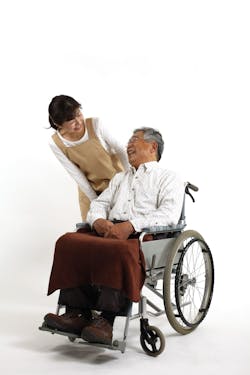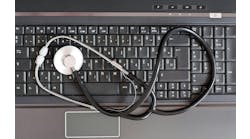According to a 2013 report by the U.S. Commission on Long-Term Care, the number of people across the U.S. who are dependent on long-term care is expected to rise from 12 million in 2010 to 27 million in 2050. This rise puts a burden on providers who must keep track of so many patients.
One way to alleviate that information-sharing problem is via technology such as electronic health records (EHRs) and mobile devices. However, according to a National Center for Health Statistics data brief released in September 2013 that relied on the 2010 National Survey of Residential Care Facilities, just 17 percent of the nation's assisted-living and other residential care communities use EHRs.
What’s more, on the hospital and physician practice side, the federal EHR incentive payment program established in 2009 has helped boost EHR adoption to approximately 80 percent of doctors in the U.S. But Congress, in establishing the program, excluded nursing homes, other long-term care facilities, assisted living and other residential care providers. According to a January 2014 report from the California Healthcare Foundation and Bluepath Health, a Calif.-based consulting firm, “HITECH [the Health Information Technology for Economic and Clinical Health Act] ignored most critical skilled nursing and interim care facilities, resulting in an enormous disconnect between the acute site and rehabilitative care. This disconnect may prove to be a significant barrier in achieving new payment models that rely on providing seamless care transitions.”
Matthew Wayne, M.D., chief medical officer of CommuniCare Family of Companies, a Blue Ash, Ohio-based provider of post-acute care with 44 buildings across four states, and former president of the American Medical Directors Association (AMDA), recently spoke with HCI Associate Editor Rajiv Leventhal about the struggles that the post-acute care market faces when it comes to technology, why there is a need for technology in this market, and how these tools specifically help. Below are excerpts from that interview.
Why is there a need for technology, such as EHRs and mobile apps, in the long-term care market?
First let’s talk about where it is similar to the physician and hospital setting. We see the post-acute and long-term care setting as a piece of the healthcare continuum to the point that healthcare as a whole is moving from a fee-for-service environment to a value-based model. The role of the EHR will be central to moving in that direction, and having it is a necessity if we’re going to improve care. That’s no different than the need to do that in office or hospital setting—it’s just as critical.
Now, what is unique about this setting? You need to appreciate that the current model of care has evolved from the long-term model of care of about 40 years ago. Even the regulations guiding that market are about 40 years old and really speak to our long-term care model where individuals who could no longer live alone needed to go to a nursing home for their care and stayed there for the rest of their days. You still see some of that, but the industry has really evolved. We are now taking care of a much-higher-complexity and often higher acuity-type patient.
The model did not evolve with a strong medical oversight. The physician would show up once a month or every other month to see his or her patient. Today, we’re moving towards a stronger medical integration. That is a key distinction—when you don’t have the daily presence of the physician. And maybe that’s where we need to move towards. You need a way to bridge that communication. How does the interdisciplinary team communicate effectively with the physician when he or she may not be there daily? In our setting, we need EHRs and mobile apps to bridge that line of communication.
In the previous model, nurses would call physicians, take an order sheet and write down the doctor’s order. Then they would send the order to the pharmacy, which would come back to the doctor. The doctor would need to sign the sheet that would then go back to the patient’s medical record. But if I gave those verbal orders, now I can go into the app on the phone—and there are push notifications to tell me that there are orders to be signed. I do that and I’m done. There are no paper processes, and all of the above-mentioned steps are eliminated.
This is a relatively new market for EHRs and mobile apps, right?
I’d say so. There are very few physician-specific EHRs that deal with the post-acute, long-term care setting. We are happy to work with our EHR vendor, PointClickCare [based in Ontario, Canada] to help them with that. But [not long ago], physicians were writing notes on paper and putting them in paper-based charts in nursing homes, or were trying to utilize the EHR from their offices and make it work in our setting. We found that to be clunky. But pioneers in this industry are now embracing the technology.
Mobile is new and exciting. Physicians often won’t be there on a routine basis, so how do we connect? The better information doctors have, the better decisions they can make about patient care. And there are two critical aspects to that: First, we have found that physicians seem to have taken to text messaging. What we have found is that when buildings reach out to call physicians, we see wait times for a response of up to an hour or more, but texts get responded to in under a minute. Physicians are very busy seeing patients, so it might be difficult to break that interaction by answering the phone since they don’t know how long a call will take. Texts don’t require that same time commitment. And some mobile apps have built in a HIPAA-compliant way of secure text messaging between physicians and the nurse at the nursing home. If it’s 8 p.m. and one of my patients has had a change of condition, the nurse could securely message me, and wouldn’t matter where I am. If I have my cell phone with me, I would get a secure message.
The second piece is being able to view the EHR remotely and being able to sign orders remotely. With some of the mobile apps, if I get that phone call, I can go into the app on my phone, go into the EHR, and view essential elements of my patient’s chart such as demographics, location, past medical history, current medication they’re taking, current vital signs, and nursing notes. If I have given orders over the phone, I can view them and sign them electronically in a compliant way. These are wins across the board for the patient, facility, nurses, doctors, and the rest of care team.
Statistics say that few long-term care facilities use EHRs. What is preventing the market from moving forward faster?
In this setting, these types of facilities were left out initially of HITECH. There wasn’t the financial incentive, but some of the industry—such as my organization—saw value in it beyond just financial implications. We saw how technology could improve care. You see that a lot of the incentives will get tied into using EHRs, yet such a critical setting of care doesn’t have that piece. So you can see why that statistic is what it is. Eventually, EHRs will have a common language and talk to each other. We must have the ability to connect to the office-based EHR, the hospital-based EHR, and the pharmacy provider. It’s absolutely essential to care moving forward, and I think that will be supported.
Has physician adoption of technology been a challenge in this industry and in your organization?
Providers might be going to several hospitals with different EHRs, so it would be easier not to have to operate different systems. I think there has been resistance in that sense. We are at the front end of that and have not yet accomplished it successfully. But we are committed to understanding the physicians’ issues: Are they just resistant to change, or are there real issues?
At my organization, we’re reaching out to buildings and embracing mobile apps. If they’re not ready, then they won’t be the first adopters. It needs to be agreed to by both sides right now, and not forced, as you don’t want to do anything that won’t improve care or their workflows. Later this year, all of my buildings will be using PointClickCare, with about two-thirds of them using it now (four buildings are using the mobile app). And we’re monitoring it—we see this is clearly moving healthcare in the right direction, so we may find that it becomes less of a choice and more of mandate moving forward.


